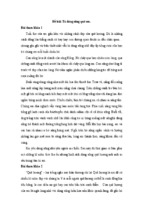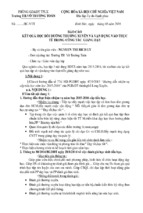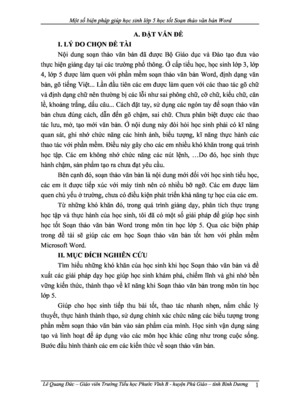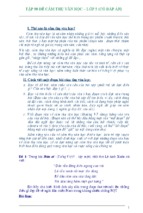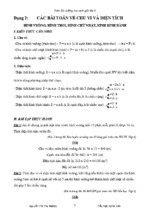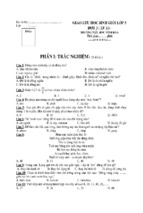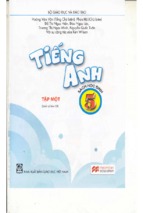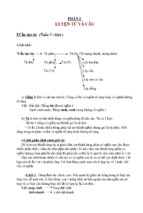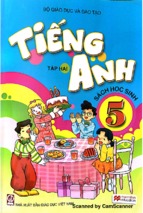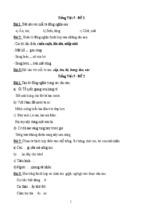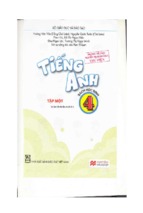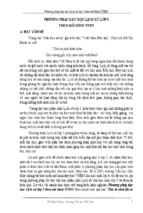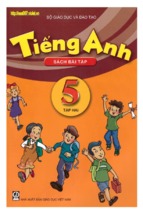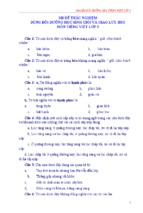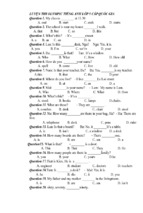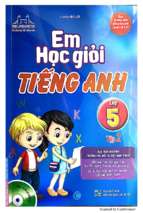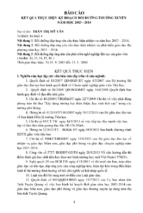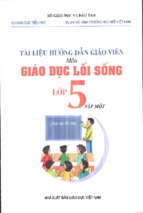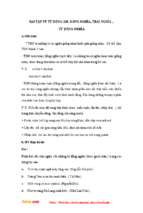Date of preparation:
UNIT 1: WHAT’S YOUR ADDRESS?
Lesson 1: Part 1-2-3
I. Objectives:
1. Knowledge:
By the end of this unit, pupils can:
•
use the words and phrases related to the topics Addresses and hometown.
•
ask and answer questions about one’s address, using What’s your address? It’s ...
2. Skills:
- Develop Ps speaking and listening skills
3. Language focus:
- Sentence Pattern: What’s your address? It’s ...
- Vocabulary: address, village, tower
II. Teaching aids:
1. Teacher’s: student’s and teacher’s book, pictures, cassette.
2. Students’: books, notebooks, workbooks.
III. Teaching processes:
1. Class organization:
2. Oral test:
3. New leson:
Teacher’s activities
I. Warm up: Play “jumbled letters” game
II. New lesson:
1. Look, listen and repeat.
Students’ activities
- Play the game
- Have the class look at the pictures. Introduce the story
by pointing at each character and elicit their answers to
the questions:
- Listen
Who’s this?
- In Picture a, Nam is greeting
Mai and introducing her to Trung,
a new pupil in their class.
What’s his/her name?
Is he/she a newcomer?
Where’s he/she from?
Where’s he/she living now?.
- Teach some new words:
Address: địa chỉ
Tower: tháp
+ Teacher read first as a model and ask the Ps to repeat
+ Have the Ps repeat in groups and individuals
- Open the tape and have the Ps listen the sound of the words.
- Play the recording a few times for pupils to listen and
- Look at the pictures and answer:
- In Picture b, Mai and Trung
greet each other. In Picture c,
Trung says he’s from Da Nang and
he lives in Ha Noi now.
- In Picture d, Mai asks him
What’s your address in ha Noi?
and he answers It’s 81, Tran hung
Dao Street.)
repeat. Do choral and individual repetition, pointing to the
characters speaking
- Instruct Ps to translate the dialogue into Vietnamese.
- Listen and copy
+ Listen and repeat
+ Groups, individuals
2. Point and say
- Tell the class that they are going to practise asking and
answering questions about one’s address, using What’s
your address? It’s ...
- Revise numbers 10 to 100 with the class.
- Point at each picture and ask the question What’s your
address? for pupils to answer chorally.
- Have pupils practise asking and answering in pairs.
Monitor the activity and offer help, if necessary.
- Invite one or two pairs to speak to check their performance.
3. Let’s talk
- Tell the class that they are going to practise further by
asking and answering questions about addresses. Get
pupils to work in groups of four to ask each other’s
addresses. Remind them to use the questions and answers
in their books.
- Set a time limit for the class to practise. Monitor the
activity and offer help, if necessary.
- Invite a few pupils to repeat their interviews to the class.
Then give feedback.
III. Reinforcement:
- Recall the main content.
V. Homework:
- Do exercises in workbook, learn by heart the new words
- Do as directed
- Listen
- Listen and copy
- Do as directed
- Listen to the teacher
- Work in pairs to do the task
- Recall
- Remember
Date of preparation:
UNIT 1: WHAT’S YOUR ADDRESS?
Lesson 1: Part 4-5-6
I. Objectives:
1. Knowledge:
By the end of this unit, pupils can:
- use the words and phrases related to the topics Addresses and hometown.
- ask and answer questions about one’s address, using What’s your address? It’s ...
2. Skills:
- Develop Ps speaking and listening skills
3. Language focus:
- Vocabulary and structures: review
II. Teaching aids:
1. Teacher’s: student’s and teacher’s book, pictures, cassette.
2. Students’: books, notebooks, workbooks.
III. Teaching processes:
1.
Class organization:
2.
Oral test:
3.
New leson:
Teacher’s activities
I. Warm up: Play the game “jumbled letters”
II. New lesson:
4. Listen and complete
• Tell pupils that they are going to listen to the recording
and complete the addresses.
• Play the recording all the way through for pupils to
listen. Play it again for them to do the task.
• Get them to compare their answers before checking as a
class. Play the recording again to confirm the answers. Give
explanations for answers which pupils find difficult.
Key: 1 .208 2 .321
3. White Street4 .the second floor
5. Read and complete
•
- Tell the class that they are going to read and fill the gaps
with street, address, lives and from. Give them a few seconds
to read the sentences. Remind them to focus on the context to
select the appropriate words from the box.
•
Set a time limit for pupils to do the task independently.
Monitor the activity and offer help, if necessary.
•
Get them to compare their answers in pairs before checking as
a class.
Key: 1. from
2. lives3 .address
4 .Street
Students’ activities
- Play the game
- Listen
- Listen to the tape
- Listen and do the task
- Answer the question.
- Listen to the teacher
- Do as directed.
- Individually
- Work in pairs
- The whole class read aloud
6. Let’s sing
- Tell Ps that they are going to sing the song “The wheels on the
bus.”.
- Have Ps read each line of the lyrics. Check comprehension.
- Open the tape and have the Ss listen the sound of the words.
- Play the tape again for Ps to do choral and individual repetition of
the song by line.
- Ask Ps to sing in choral
- Have Ps practice singing in groups.
- Have class sing the song again to reinforce their pronunciation.
III. Consolidation
- Retell the content of the lesson.
IV. Homework
- Do exercises in the workbook. Prepare the next period.
- Listen to the teacher
- Read each line of the lyrics
- Listen to the tape
- Listen and repeat each line
- The whole class
- Practice in groups
- The whole class
- Retell
- Remember
*************************************************************************
Date of preparation:
UNIT 1: WHAT’S YOUR ADDRESS?
Lesson 2: Part 1-2-3
I. Objectives:
1. Knowledge:
- By the end of the lesson, Ps will be able to• ask and answer questions about what a
village/town/city is like, using What’s the ... like? It’s ...
2. Skills:
- Develop Ps speaking and listening skills.
3. Language focus:
- Vocabulary: city, village, busy, quiet..
- Structures: What’s the ... like? It’s ...
II. Teaching aids:
1. Teacher’s: student’s and teacher’s book, pictures, cassette.
2. Students’: books, notebooks, workbooks.
III. Teaching processes:
Teacher’s activities
I. Warm up: Sing the song “The wheel on the bus?”
II. New lesson:
1. Look, listen and repeat
•
•
Tell the class that they are going to read a story.
Have them look at the pictures and guess what the
story is about. Check their comprehension by pointing at
each picture to elicit their answers to these questions:
What’s his name? Who’s he talking with? Where does he
live? What’s the village like? (
Play the recording all the way through for pupils to
listen and follow in their books. Play it again for them to
repeat the lines in the bubbles. Finally, point to each
picture for them to say the words in each bubble.
- Instruct Ps to translate the dialogue into Vietnamese.
•
Students’ activities
- Sing the song
- Listen
- Look at the pictures and answer:
•
Nam is talking to Trung. In
Picture a, Nam asks what Trung’s
hometown is and Trung says it’s
Da Nang.
•
In Picture b, Nam asks about
where Trung lived and Trung says
he lived in a village.
•
In Picture c, Nam asks What’s
your village like? and Trung
answers It’s small and quiet.
In Picture d, Nam asks if it’s
beautiful and Trung says it is.)
- Listen
•
2. Point and say
• - Tell the class that they are going to practise the
questions and answers describing a place, using
What’s the ... like? It’s ...
• Revise the adjectives big, far, large and small and teach
the new ones: busy, quiet, crowded and pretty. Have
the class repeat all the adjectives twice before asking
them to practise saying sentences. (E.g. My city is big
and busy. My village is far and quiet.)
• Point at the pictures and ask What’s the ... like? for the
class to answer, using the prompts.
• Ask them to work in pairs. Monitor the activity and offer
- Listen and repeat
- Do as directed
- Listen
- Listen and copy
+ Listen and repeat
+ Groups, individuals
- Listen and copy
help, if necessary.
Invite one or two pairs to perform the activity. Then give
feedback
3. Let’s talk:
- Do as directed
- Tell Ps that they are going to revise what they have learnt in
- Listen
Lessons 1 and 2, using facts about themselves.
- Ask them to work in pairs and ask and answer the questions:
- Work in pairs
What time is it? What time do you + activity?
- Call on a few pairs to role-play in front of the class. Correct
- Some pairs perform in front of class
pronunciation, if necessary.
III. Consolidation:
- Listen to the teacher
- Summary the lesson
IV. Homework:
- Remember
- Do exercises in workbook, learn by heart the new words
*************************************************************************
Date of preparation:
UNIT 1: WHAT’S YOUR ADDRESS?
Lesson 2: Part 4-5-6
I. Objectives:
1. Knowledge:
By the end of the lesson, Ps will be able to•:
- use the words and phrases related to the topics Addresses and hometown.
- ask and answer questions about what a village/town/city is like, using What’s the ...
like? It’s ...
2. Skills:
- Develop Ss reading, writing and listening skills
3. Language focus:
- Vocabulary: Review
II. Teaching aids:
1. Teacher’s: student’s and teacher’s book, pictures, cassette.
2. Students’: books, notebooks, workbooks.
III. Teaching processes:
Teacher’s activities
I. Warm up: Play the game: Order the words
II. New lesson:
4. Listen and circle a or b.
• - Tell the class that they are going to listen and circle a or b to
complete the sentences. Ask them to read the sentences and
guess the correct answers.
• Play the recording all the way through for them to
listen. Play it again for them to do the task.
• Get them to compare their answers before giving feedback.
Key: 1 a
2b
3b
4a
5. Write about you
• - Tell the class that they are going to write about where
they live and who they live with. Have them read the
questions and check their understanding.
• Set a time limit for them to do the task. Monitor the activity
and offer help, if necessary.
• Get them to swap and read their writing before inviting one
or two pupils to read their answers aloud and give feedback.
Key: Answers vary
6. Let’s play:
•
Tell the class that they are going to play Spot the difference.
Tell them that they have to compare the two pictures and find out
the five details which are different. The first pupil who finds out all
the different details is the winner.
Key: Picture b is different from Picture a in the following ways:
•
There is one more car in the road.
•
There is a woman in front of the yellow building.
•
The sign next to the yellow building is blue, and it reads
BUS STOP.
•
There is no logo of pills on the pharmacy.
•
There is a boy behind the father and daughter.
III. Consolidation
Students’ activities
- Play game
- Listen to the teacher
- Listen to the tape
- Listen and do the task
- Listen
- Do the task
- Individually
- Work in pairs
- Some Ps
- The whole class
- Listen
- Do as directed
- Listen
- Play in groups
- Summary the lesson
IV. Homework
- Do exercises in workbook, prepare the next period.
- Listen
- Remember
Date of preparation:
UNIT 1: WHAT’S YOUR ADDRESS?
Lesson 3: Part 1-2-3
I. Objectives:
1. Knowledge:
• - By the end of the lesson, Ps will be able to pronounce two-syllable words with the stress
on the first syllable: 'city, 'village, 'mountains and 'tower.
2. Skills:
- Develop Ps writing and listening skills
3. Language focus:
- Vocabulary and structures: Review
• - Phonics: stress on the first syllable: 'city, 'village, 'mountains and 'tower.
II. Teaching aids:
1. Teacher’s: student’s and teacher’s book, pictures, cassette.
2. Students’: books, notebooks, workbooks.
III. Teaching processes:
Teacher’s activities
I. Warm up: Play game: Pass the secret!
II. New lesson:
1. Listen and repeat
Students’ activities
- Play the game
• Tell the class that they are going to practise saying two-syllable
- Listen to the teacher
- Listen to the tape
- Listen and repeat in choral,
groups and individual
words with the stress on the first syllable. Explain that in a
word with more than one syllable, one of the syllables is usually
said with more emphasis than the rest (e.g. 'city, 'village,
'mountains and 'tower).
• Play the recording all the way through for pupils to listen and
follow in their books. Then play it again for them to repeat all
the words and sentences twice.
2. Listen and circle. Then say aloud
• - Tell the class that they are going to listen and circle a or b to
complete the sentences.
• Give them a few seconds to read the sentences in silence
before playing the recording for them to do the task.
- Listen to the teacher
- Look at the books and guess
- Listen and write
- Listen and check
- Read aloud
• Get them to compare their answers in pairs before checking as
a class.
Key: 1 b 2 a 3 a
3. Let’s chant
• - Tell the class that they are going to say the chant Where do
you live? Have them read the chant and check their
comprehension.
- Listen to the teacher
- Read the chant
- Do as directed
• Play the recording all the way through for pupils to listen
and follow in their books. Then play it again for them to
repeat line by line.
• Put the class into two groups to practise chanting: one
- Practice in groups
- Work in pairs
chants the questions and the other chants the answers.
• Have them practise chanting and doing actions in groups.
- The whole class
• Invite two or three groups to say the chant and do actions.
III. Consolidation
- Listen
- Summary the lesson
IV. Homework
- Remember
- Do exercises in workbook, prepare the next period.
*************************************************************************
Date of preparation:
UNIT 1: WHAT’S YOUR ADDRESS?
Lesson 3: Part 4-5-6-7
I. Objectives:
2. Knowledge:
- By the end of the lesson, Ps will be able to use words and phrases related to
the topic about addresses and hometowns.
2. Skills:
- Develop Ps writing and listening skills
3. Language focus:
- Vocabulary and structures: review
II. Teaching aids:
1. Teacher’s: student’s and teacher’s book, pictures, cassette.
2. Students’: books, notebooks, workbooks.
III. Teaching processes:
Teacher’s activities
Students’ activities
I. Warm up: Spend a few minutes having the class say the chant - Read the chant
Where do you live?chant
II. New lesson:
4. Read and tick Y/N
•
Tell the class that they are going to read the text and tick
Yes or No.
•
Get them to read the sentences and underline the key
words/phrases before reading the passage to find the relevant
information. Give them an example: In Sentence 1, Trung
lives with his parents in ha Noi. But in the passage, the
information is: Trung lives with his grandparents in ha Noi. So
pupils should tick the box No.
• Set a time limit for pupils to do the task independently.
Monitor the activity and offer help,
if necessary.
• Have them compare their answers before checking as a
class.
- Listen to the teacher
- Read the paragraph
- Individually
- Work in pairs
- Some Ps
- Answer the T’s question
- The whole class
Key: 1 N 2 Y 3 N 4 Y 5 Y
5. Write about your friend
•
- Tell the class that they are going to write about one of their
friends.
- Listen to the teacher
•
Give them time to read the questions and write the first draft
of their answers in their notebooks.
- Do as directed
• Set a time limit for them to do the task independently.
Monitor the activity and offer help, if necessary.
• Remind them to write the first letter of each sentence and
the name of their friend in capital letters, and put commas
and full stops at the appropriate places.
• Get them to swap and read their writing in pairs before
- Write
- Work in pairs
- The whole class
- Listen
inviting two or three pupils to read their answers aloud.
Key:
6. Project
Answers vary
• Tell the class that they are going to do a drawing project.
They should work in groups to discuss the house they are
going to draw, and its address. Then ask them to draw it on
a piece of paper.
• Set a time limit for them to do the task.
• Invite a few groups to present their drawings to the class and
talk about them.
• If there is not enough time, give the activity as homework
and talk about the drawings in the next lesson as a warm-up
activity.
-
Work in groups
-
Do the task
• Display their drawings in the classroom if you wish.
7. Colour the star
•
Have the class read the statements and check their
comprehension.
•
Give them time to colour the stars and invite a few pupils to
read the statements aloud.
•
Give further support to pupils who find it difficult to achieve
certain objectives.
III. Consolidation
- Summary the lesson
IV. Homework
- Do exercises in workbook, prepare the next period.
-
Read the statements
Colour the stars
- Listen
- Remember
*************************************************************************
Date of preparation:
UNIT 2: I ALWAYS GET UP EARLY. HOW ABOUT YOU?
Lesson 1: Part 1-2-3
I. Objectives:
3. Knowledge:
- By the end of the lesson Ps will be able to :
• ask and answer questions about someone’s daily routine, using What do you
do ...?
I always/usually/often/sometimes. . .
• ask and answer questions about frequency, using How often ...? I ... every
day/once/twice ... a week/a month.
• pronounce two-syllable words with the stress on the first syllable: 'always, 'usually,
'often
and 'sometimes.
2. Skills:
- Develop Ps speaking and listening skills
3. Language focus:
- Sentence Partners: What do you do ...? I always/usually/often/sometimes ...
- Vocabulary: Always, breakfast, late, get up..
II. Teaching aids:
1. Teacher’s: student’s and teacher’s book, pictures, cassette.
2. Students’: books, notebooks, workbooks.
III. Teaching processes:
Teacher’s activities
I. Warm up: Play “jumbled letters” game
Students’ activities
- Play the game
II. New lesson:
1. Look, listen and repeat.
- Have the class look at the pictures. Introduce the
story by pointing at each character and elicit their
answers to the questions: Who’s this? What’s he
doing? Who’s he talking with online? What does he
do in the morning? What does he do after school/in
the afternoon?
- Listen
- Teach some new words:
+ Listen and repeat
+ Groups, individuals
- Listen
+ brush one teeth: đánh răng..
+ do morning exercise: tập thể dục
+ talk: nói chuyện
• Play the recording all the way through for pupils
to listen and follow in their books. Play it again
for them to repeat line by line.
• Check their understanding of the story.
- Instruct Ps to translate the dialogue into Vietnamese.
2.Point and say
• - Tell the class that they are going to practise asking
and answering questions about someone’s daily
routines, using What do you do in the
morning/afternoon/evening? I always/usually/often/
sometimes ...
• Have pupils look at the pictures. Teach them how to read
the words and phrases under each picture.
• Ask them to pay attention to the pronunciation of the
words: 'always, 'usually, 'often and
'sometimes.
• Point at each picture and ask the question What do
you do ...? for pupils to answer chorally, using the
information under the picture.
• Have them practise asking and answering the
questions in pairs. Then invite one or two pairs to
speak to check their performance.
- Look at the pictures and answer
the T’s questions
- Listen and copy
- Listen and repeat
- Do as directed
- Listen to the teacher
- Work in pairs
•
3.Let’s talk
• Tell the class that they are going to practise further by
asking and answering questions about someone’s daily
routines. Get pupils to work in pairs. Remind them to
-
Listen to the teacher
Do the task
use the questions and answers in their books.
• Set a time limit for them to practise. Monitor the activity
and offer help, if necessary.
• Invite a few pairs to act out their conversations. Then give
feedback.
- Recall
III. Reinforcement:
- Remember
- Recall the main content.
V. Homework:
- Do exercises in workbook, learn by heart the new words
*************************************************************************
Date of preparation:
UNIT 2: I ALWAYS GET UP EARLY. HOW ABOUT YOU?
Lesson 1: Part 4-5-6
I. Objectives:
3. Knowledge:
By the end of the lesson Ps will be able to :
• ask and answer questions about someone’s daily routine, using What do you
do ...?
I always/usually/often/sometimes. . .
2. Skills:
- Develop Ps speaking and listening skills
3. Language focus:
- Vocabulary and structures: review
II. Teaching aids:
1. Teacher’s: student’s and teacher’s book, pictures, cassette.
2. Students’: books, notebooks, workbooks.
III. Teaching processes:
1.
Class organization:
2.
Oral test:
3.
New leson:
Teacher’s activities
I. Warm up: Play the game “jumbled letters”
II. New lesson:
4. Listen and tick
• Tell the class that they are going to listen to the
recording and tick the correct pictures.
• Ask them to look at the pictures to identify the
Students’ activities
- Play the game
- Listen
- Listen to the tape
characters and their activities.
• Play the recording all the way through for pupils to
- Listen and do the task
- Answer the question.
listen and tick the pictures. Play it again for them to
check their answers. Monitor the activity and offer
help, if necessary.
• Get pupils to compare their answers before checking
as a class. Play the recording a third time to confirm
the answers.
Key: 1 c 2 b 3 b 4 a
5. Read and complete
•
Tell the class that they are going to read and fill the
gaps with like, do, TV, play and usually.
•
Give them a few seconds to read the text and the
words in the box. Remind them to focus on the context
to select the appropriate words.
•
Set a time limit for pupils to do the task
independently. Monitor the activity and offer help, if
necessary.
•
Get pupils to compare their answers in pairs before
checking as a class. If there is enough time, have the
class read the completed text aloud.
•
Key: 1 do 2 usually
3 play 4 TV 5 like
6Let’s sing
• - Tell the class that they are going to sing the song
This is the way we do things. Have pupils read
each line of the lyrics and teach the unfamiliar
words. Check comprehension.
• Play the recording all the way through for pupils
to listen and follow in their books. Play it again
and ask pupils to do choral repetition line by line.
• When pupils are familiar with the melody, ask the
class to sing along with the music before having
them practise singing and doing actions in groups.
• Invite a group to sing the song and do actions in
front of the class.
•
III. Consolidation
- Retell the content of the lesson.
IV. Homework
- Do exercises in the workbook. Prepare the next period.
- Listen to the teacher
- Do as directed.
- Individually
- Work in pairs
- The whole class read aloud
- Listen to the teacher
- Read each line of the lyrics
- Listen to the tape
- Listen and repeat each line
- The whole class
- Practice in groups
- The whole class
- Retell
- Remember
*************************************************************************
Date of preparation:
UNIT 2: I ALWAYS GET UP EARLY. HOW ABOUT YOU?
Lesson 2: Part 1-2-3
I. Objectives:
1. Knowledge:
• - By the end of the lesson, Ps will be able to :
• ask and answer questions about frequency, using How often ...? I ... every
day/once/twice ... a week/a month.
• pronounce two-syllable words with the stress on the first syllable: 'always, 'usually,
'often and 'sometimes.
2. Skills:
- Develop Ps speaking and listening skills.
3. Language focus:
- Vocabulary: usually, study, go fishing, once..
• - Structures: How often ...? I ... every day/once/twice ... a week/a month.
II. Teaching aids:
1. Teacher’s: student’s and teacher’s book, pictures, cassette.
2. Students’: books, notebooks, workbooks.
III. Teaching processes:
Teacher’s activities
I. Warm up: Spend a few minutes revising the previous
lesson by having the class sing the song
This is the way we do things.
II. New lesson:
1. Look, listen and repeat
• Tell the class that they are going to read a story.
Have them look at the pictures and guess what the
story is about. Check their comprehension by
pointing at each picture to elicit their answers to
these questions: What’s his/her name? What’s
he/she talking about? What kind of information is
Linda looking for? How often does she come to the
library?
Students’ activities
- Sing the song
- Listen
- Look at the pictures and answer
- Listen
- Listen and repeat
• Play the recording all the way through for pupils to
listen and follow in their books. Play it again for
them to repeat the lines in the bubbles. Then point
to each picture for them to say the words in each
bubble.
2Point and say
Tell the class that they are going to practise asking and
answering questions about frequency, using How often ...? I
... every day/once/twice ... a week/a month.
•
Point at each picture and ask Howoftendoyou...? to get
the class to answer, using the prompts under each picture.
•
Ask pupils to work in pairs: one asks the question and
the other answers the question. (E.g.
•
A: How often do you go to the library? B: I go to the
library once a week.)
•
Invite one or two pairs to perform the activity. Then give
feedback
3.Let’s talk:
•
• - Tell the class that they are going to practise talking
about their daily routines and how often they do
something, using What do you do ...? I usually ... and
How often ...? I ... once/twice ... a week/a month.
• Get pupils to work in pairs. Remind them to use the
- Do as directed
- Listen
- Listen and copy
+ Listen and repeat
+ Groups, individuals
- Listen and copy
- Do as directed
- Listen
- Work in pairs
- Some pairs perform in front of class
questions in their books and any other questions
they can think of.
• Set a time limit for them to practise. Monitor the activity
and offer help, if necessary.
• Invite a few pairs to ask and answer questions about
their daily routines and how often they do
something. Then give feedback.
.
- Listen to the teacher
- Remember
III. Consolidation:
- Summary the lesson
IV. Homework:
- Do exercises in workbook, learn by heart the new words
*************************************************************************
Date of preparation:
UNIT 2: I ALWAYS GET UP EARLY. HOW ABOUT YOU?
Lesson 2: Part 4-5-6
I. Objectives:
1. Knowledge:
• - By the end of the lesson, Ps will be able to :
• ask and answer questions about frequency, using How often ...? I ... every
day/once/twice ... a week/a month.
2. Skills:
- Develop Ss reading, writing and listening skills
3. Language focus:
- Vocabulary: Review
II. Teaching aids:
1. Teacher’s: student’s and teacher’s book, pictures, cassette.
2. Students’: books, notebooks, workbooks.
III. Teaching processes:
Teacher’s activities
I. Warm up: Play the game: Order the words
II. New lesson:
4. Listen and number
• Tell the class that they are going to listen and number the
pictures.
• Ask pupils to look at the pictures and identify the characters
and their activities.
• Play the recording all the way through for them to listen
and number the pictures. Play it again for them to check
their answers.
• Get pupils to compare their answers before checking as a
class.
• Play the recording a third time to confirm the answers.
Key: a 4
b1
c2
d3
5. Write about your daily routines
• Tell the class that they are going to write about their daily
routines.
• Have them read the questions and check their understanding.
• Set a time limit for them to write the answers in their
notebooks. Monitor the activity and offer help, if necessary.
• Get them to swap and read each other’s answers before
inviting one or two pupils to read their answers aloud.
• Key:
Answers vary
6Let’s play:
••
Tell the class that they are going to complete a
crossword puzzle. Remind them how to do it: they
Students’ activities
- Play game
- Listen to the teacher
- Listen to the tape
- Listen and do the task
- Listen
- Do the task
- Individually
- Work in pairs
- Some Ps
- The whole class
should look at each picture and complete the
corresponding word, using the given letters as hints.
• Get them to look at the crossword puzzle and the pictures.
Start with Picture 1 and ask them to think of a verb that
describes it. Then tell them to check whether the spelling
fits the letters/boxes in the puzzle. Repeat the procedure
for the rest of the pictures. The first pupil who completes
the puzzle correctly is the winner.
• Ask pupils to work independently. Monitor the activity.
• Meanwhile, copy the crossword puzzle on the board and
invite one or two pupils to complete it. Ask them to read
out the words for the class to repeat. Ask the class to
compare their answers to those on the board.
• Have the class make sentences with the words and phrases
from the puzzle.
Key: 1 get dressed 2 cook dinner 3 have lunch 4 do
homework
5 go home
6 go to bed 7 listen to music 8 get up
9 go
to school
III. Consolidation
- Summary the lesson
IV. Homework
- Do exercises in workbook, prepare the next period.
- Listen
- Do as directed
- Listen
- Play in groups
- Listen
- Remember
Date of preparation:
UNIT 2: I ALWAYS GET UP EARLY. HOW ABOUT YOU?
Lesson 3: Part 1-2-3
I. Objectives:
1Knowledge:
• - pronounce two-syllable words with the stress on the first syllable: 'always, 'usually,
'often and 'sometimes.
2. Skills:
- Develop Ps writing and listening skills
3. Language focus:
- Vocabulary and structures: Review
• - Phonics stress on the first syllable: 'always, 'usually, 'often and 'sometimes.
• II. Teaching aids:
1. Teacher’s: student’s and teacher’s book, pictures, cassette.
2. Students’: books, notebooks, workbooks.
III. Teaching processes:
Teacher’s activities
I. Warm up: Play game: Pass the secret!
II. New lesson:
2. Listen and repeat
Students’ activities
- Play the game
• Tell the class that they are going to practise saying two-syllable
- Listen to the teacher
- Listen to the tape
- Listen and repeat in choral,
groups and individual
words with the stress on the first syllable: 'always, 'usually,
'often and 'sometimes.
• Play the recording all the way through for pupils to listen first.
Play the recording again for them to repeat the words and the
sentences twice.
• .
2. Listen and circle. Then say aloud
• - Tell the class that they are going to listen and circle a or b to
complete the sentences.
• Give them a few seconds to read the sentences in silence
- Listen to the teacher
- Look at the books and guess
- Listen and write
- Listen and check
- Read aloud
before playing the recording for them to do the task.
• Get them to compare their answers in pairs before checking as
a class.
Key: 1 a
2b
3. Let’s chant
3a
4b
• Tell the class that they are going to say the chant What do you
do in the morning? Have pupils
read the chant and check their comprehension.
• Play the recording all the way through for them to listen
and follow in their books. Play it again for them to repeat
line by line.
- Listen to the teacher
- Read the chant
- Do as directed
- Practice in groups
- Work in pairs
• Put the class into two groups to practise chanting the questions
and the answers respectively.
- The whole class
• Have them practise saying the chant and do actions in
groups.
• Invite two groups to the front of the class to say the chant and
- Listen
do actions. The rest of the class claps along to the rhythm.
- Remember
III. Consolidation
- Summary the lesson
IV. Homework
- Do exercises in workbook, prepare the next period.
*************************************************************************
Date of preparation:
UNIT 2: I ALWAYS GET UP EARLY. HOW ABOUT YOU?
Lesson 3: Part 4-5-6-7
I. Objectives:
4. Knowledge:
- By the end of the lesson, Ps will be able to use words and phrases related to
the topic Daily routines
2. Skills:
- Develop Ps writing and listening skills
3. Language focus:
- Vocabulary and structures: review
II. Teaching aids:
1. Teacher’s: student’s and teacher’s book, pictures, cassette.
2. Students’: books, notebooks, workbooks.
III. Teaching processes:
Teacher’s activities
Students’ activities
Warm up: Spend a few minutes having the class say the - Read the chant
chant What do you do in the morning?
II. New lesson:
4. Read and answer
- Listen to the teacher
•
Tell the class that they are going to read the text and answer
the questions.
- Read the paragraph
•
Give them a few seconds to look at the picture and ask:
I.
Who’s this? What’s she doing? What’s she watching?
•
Explain the meanings of the new words: go jogging,
programme.
• Set a time limit for them to read the text and do the task
independently. Monitor the activity and offer help, if
necessary.
• Have pupils compare their answers before checking as a
class.
Key: 1 She gets up early and usually goes jogging.
- Individually
- Work in pairs
- Some Ps
- Answer the T’s question
- The whole class
2 She usually does her homework. Then she
often plays badminton and sometimes cooks
dinner.
3 She watches English for Kids (once a week).
4 She goes shopping twice a week.
5. Write about your day
- Listen to the teacher
- Do as directed
- Write
- Xem thêm -

